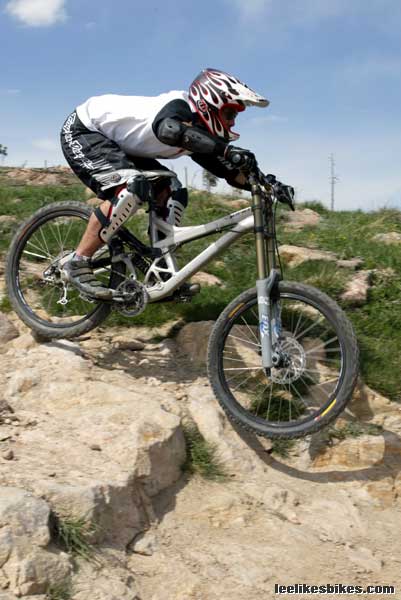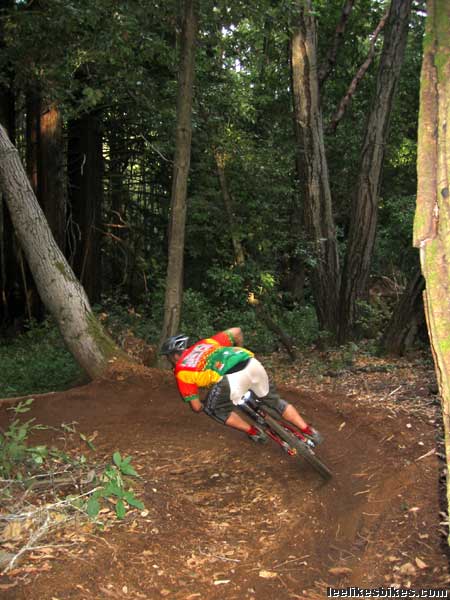Upper body armor for trail riding?

Hi Lee;
I went over the handlebars twice last season, landing once on each shoulder. After spending the winter with James Wilson’s DB Combo and The Ultimate programs, things are good.
Just wondering what your thoughts are on upper body/shoulder armor for TRAIL riding. Most of what I’ve seen seems geared to DH riders. IE not a lot of ventilation and bulky looking. I came across this product with looks like it might have some potential, given the ability to remove the shoulders and the two way front zipper. http://www.skeletools.com/SearchResults.asp?Cat=1
Feedback is welcome from one and all.
Cheers Greg
 DH bike and crazy rocks = full-on armor (I hiked up this hill; why not carry protection?). |
Hey Greg,
Protective gear is a tricky area. I believe helmets and gloves are mandatory. Beyond that, you should wear whatever it takes to ride with full confidence.
For many riders that’s knee guards. Others add elbow guards. Others rock full body armor, and a few are starting to roll with Leatt neck braces. It’s a personal decision, and it’s a function of your skills, physical fitness, the riding conditions and your confidence.
Hmm. This is a complex question with no clear answer. Let’s hack at it:
What are you guarding against?
– Impact. Hard-shell armor dissipates impact force, and it protects you from “intrusions.” If you want to protect yourself from blunt force trauma (ground, rock, tree), armor is the way.
– Violent motion of the joint. Armor won’t do much for you there. Good news: If you’re following James’ programs, you’re already making your shoulders about as supple and stable ad they can be.
Realize it’s a tradeoff
From a protective standpoint, more armor is almost always a good idea. If you feel compelled to wear upper body armor on trail, by all means do it. But realize it has drawbacks:
– Weight.
– Restrictiveness.
– Heat.
– Uncool factor (the key consideration for too many riders).
– It scares other trail users. I don’t care whether you’re carrying your IMBA card; armor and full-face helmets freak out hikers and XC riders.
Every time you get dressed to ride, you are weighing the benefits and drawbacks of more protection. I typically wear light knee guards when I pin XC downhills. They’re easy to carry (low drawback), and they save me significant pain when I screw up (high benefits). And I almost always coach in knee guards. Why? I’m usually riding, talking and paying attention to someone else — and I fall often. In that situation, knee guards are high possible benefit, low drawback. So I rock ’em.
 Loamy Santa Cruz love = light neoprene knee guards (when it’s cold out they double as knee warmers). |
Don’t skimp!
If you decide to wear upper armor for trail riding, it MUST fit you perfectly. I can’t comment directly on that Skeletools jacket, but I’ll say this:
I’ve experimented with various armor over the years, and I keep coming back to Dainese — at full retail price. My first DH suit lasted over 10 years. I now have a full suit for DH, and a jacket for moto. Dainese is almost 3X the cost of other armor, but, in my experience, it’s the most comfortable and wearable.
If you do this, do it right. The only useful armor is the kind you actually wear.
What are you afraid of?
I wear full armor only for full-speed race-style downhill runs (and moto). For me, those are the only times the benefit/drawback equation works in armor’s favor.
I propose that your regular trail rides shouldn’t be that risky.
1) If you pin it full-on every day to the point where you need (and use) armor, you should ask yourself if that’s a good idea. Especially if you’re older and/or have been hurt.
2) If the terrain, speed and your inabilities are that threatening to your safety … well, you know what I’ll say next: Ride somewhere else. Slow down. Work on your skills.
For a lot of riders, especially the older, been-hurt-before kind, wearing armor actually holds them back. It makes them too self conscious and aware of the risk of falling. That’s no fun.
To sum it up:
1. Wear whatever you need to feel safe and confident. Don’t go cheap.
2. Do what it takes to make your riding intrinsically safer.
First skills and fitness, then confidence, then braaap!
— Lee
Know more. Have more fun!
Join the leelikesbikes mailing list:

Comments are closed.